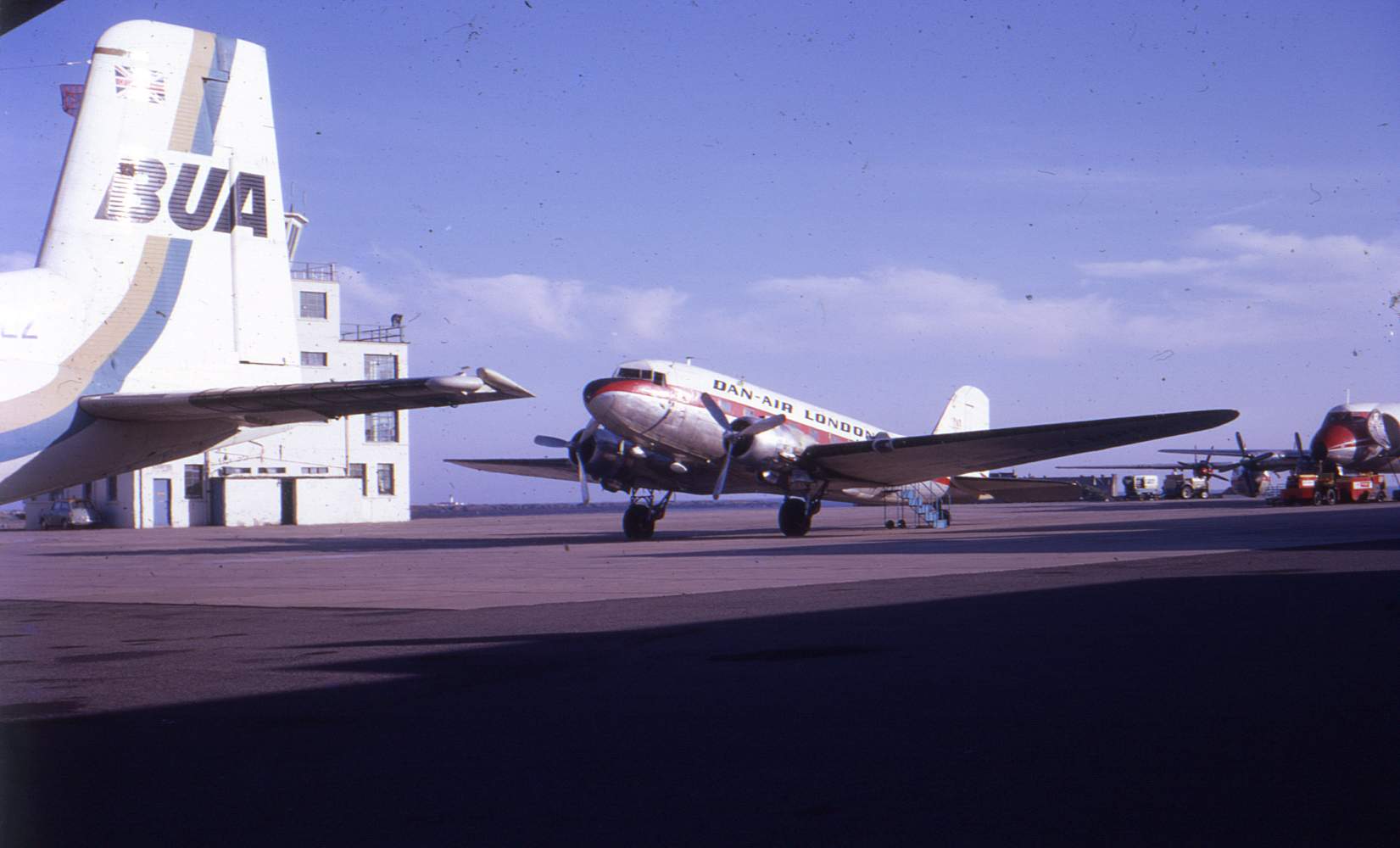
233 Squadron didn’t fly on September 24th 1944 but limited post-Arnhem operations recommenced on 25th with KG441 and FZ686 performing logistics flights carrying parachutes and newspapers to Brussels while FZ666 took newspapers to B6/ Coulombs. Eleven aircraft were separately dispatched to B56/ Brussels during the day with panniers, petrol and ammunition. They were led by Wing Commander Coles and their payload totalled 49,600 lbs. The air traffic around Brussels Evere was intense and four of the eleven landed at B60/ Grimbergen until the congestion cleared. Aircraft on the return leg to Down Ampney carried, between them, 100 stretcher cases and 104 walking wounded.
A similar pattern of flights took place on 26th and 27th September with groups of eight aircraft dispatched for the Continent each day. On 26th 40,500 lbs of ammunition was taken to B58/ Melsbroek before the aircraft flew on to Brussels Evere. While four Dakotas returned empty to base, the remaining four embarked a total of 72 stretchers and 12 walking wounded for the flight to Broadwell. Flt. Lt. Cody DFC piloted KG447 to B43/ St.Omer with newspapers and Flying Officer Priestley took KG415 to B56/ Brussels, also with newsprint. Both returned to Down Ampney carrying wounded personnel. 27th September saw another eight Dakotas departing Blakehill Farm just after 09:00 with a total of 472 drop tanks destined for B59/ Ypres to replenish stocks used by fighter bomber squadrons during Market Garden. They returned in the early afternoon, just in time to be assigned a mission to the obscure airfield of Matlaske in Norfolk. Eleven 233 Squadron Dakotas touched-down at Matlaske around 18:00 that evening and were serviced and loaded ready for departure to B60/ Grimbergen on the morning of 28th September. Their load comprised 76 passengers and 36, 960 lbs of equipment for the Hawker Tempest squadrons 3, 56 and 486 which were being relocated to Belgium. From B60, four aircraft flew passengers north to Grave in the Netherlands, close to the front line established during Market Garden. The remaining seven aircraft lifted 68 passengers and 22,700 lbs of equipment for the Spitfire and Mustang squadrons 19, 65 and 122 rotating back to Matlaske. Upon arrival in Norfolk, three Dakotas unloaded and returned to Blakehill Farm and four loaded with 11,500 lbs of freight ready to continue moving tempest squadrons to Grimbergen the following morning. During the day, one of 233 Squadron’s Ansons, NK447, took Lady Tedder, wife of Air Chief Marshall Sir Arthur Tedder, Deputy Commander in Chief of the Allied Expeditionary Force, to B56/ Brussels.
Freight and mail flights were run on 29th September to B56/ Brussels Evere and B6/ Coulombs along with medical supplies. Passengers were returned to the US base at Barkston Heath, home to Virginia Ann’s 61st Troop Carrier Group (see D-Day Squadron thread). Five aircraft also returned, to Woodhall Spa, 110 personnel who had survived from the 1st Airborne force at Arnhem. 344 drop tanks had been carried on the outbound flight from Bicester to B56.
The last day of September saw six 233 Squadron Dakotas exchanging Spitfire squadron personnel with crews and equipment from 130 and 412 Squadrons carried overseas from Hawkinge to B70/ Antwerp and personnel from 132 and 441 Squadrons carried on the return. A further 3 aircraft transported a telephone switchboard to B56/ Brussels.
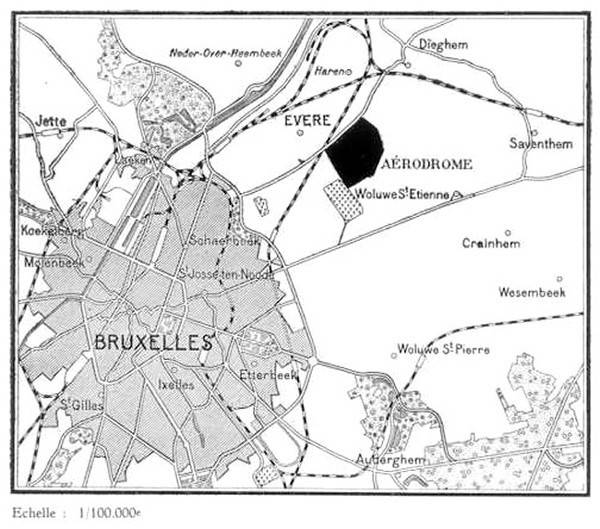
October 1944 soon saw a pattern established: a large fleet of Dakotas would depart each day for B56/ Brussels carrying fuel, ammunition and equipment as well as home comforts for the troops such as mail and newspapers. Initially, return flights carried injured soldiers to Broadwell and Down Ampney and returned 1st Airborne personnel and equipment to Broadwell. As the days after Market Garden passed, less casualties were evacuated and more flights returned empty.
1st October: 10 Dakotas from 233 Squadron flew to B56/ Brussels
2nd October: Seventeen 233 Sqdn Dakotas to B56.
4th October: Fourteen 233 Sqdn aircraft to Evere.
5th October: Seven 233 Sqdn Dakotas to Brussels.
6th October: Twelve 233 Squadron aircraft to B56
7th October: 10 Dakotas to B56/ Evere.
In addition to this, there were many passenger flights to B56/ Evere and B59/ Ypres, mail flights to B6/ Coulombs and the steady supply of drop tanks to fighter-bomber squadrons. Four aircraft carried 76 WAAFs from Northolt to B48/ Amiens on October 3rd and a ‘Top Secret’ load of 66 barrels was carried from Brussels to Blakehill under armed guard on October 1st. Apart from that, operations were routine. FZ681 returned on October 5th from repair to damage sustained on the Arnhem mission. Her crew on the Arnhem resupply mission, Warrant Officers Barry Stableford and Terry Holmes, were back in action the following day with an Anson flight delivering maps and a passenger to A47/ Paris Orly. Their luck remained good, the weather was poor enough to necessitate a stay in Paris until October 8th. During the second week of October, FZ681 was flown by a succession of crews: F.O Fran, P.O.Wright, W.O. Lee, P.O. Dijkstra, F.O.Merricks and F.O.Priestley, mostly on missions to Brussels. By 11th October, 233 Squadron aircraft were making occasional onward flights from Brussels to air strips closer to the front line, such as B78/ Eindhoven.
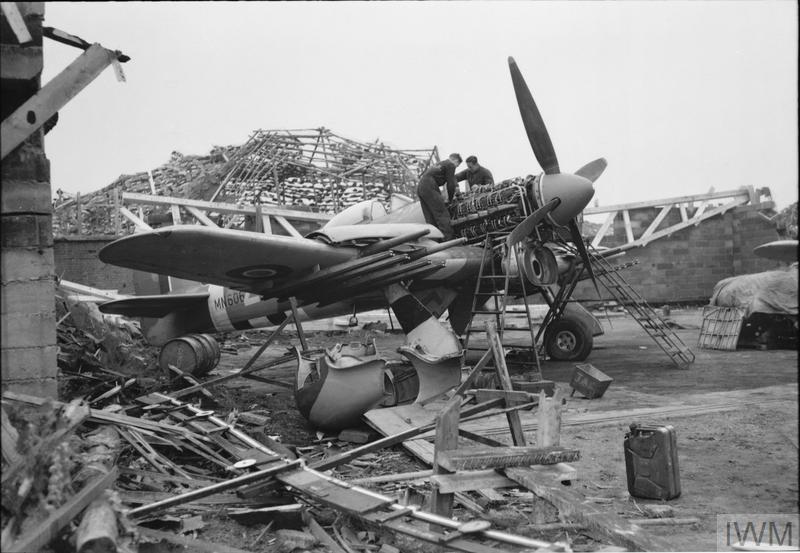
The mail and newspaper runs continued, with up to six aircraft supplying B17/ Caen, B56/ Evere, B58/ Melsbroek and B61/ Sint Denijs-Gent on October 14th. Given congestion at Evere, many flights were routed to the adjacent airfield at Melsbroek. During mid-October, the airport at Antwerp/ B70 was also a regular destination for 233 Squadron passenger flights routed via Northolt. Return flights brought casualties home Broadwell or Down Ampney and passengers to Northolt and Blackbushe (then named Hartford Bridge). Flying Officer Priestley became a regular pilot of FZ681 with Sgt J.Bright, F/L R.Taylor and Flt Sgt D.Morris as crew. On 28th October F.O.Priestley positioned FZ681 from Blakehill to the 38 Group Stirling base at Wethersfield and then transported passengers to A63/ Villeneuve. The return leg via Wethersfield had FZ681 back at Blakehill Farm by 17:54.
The Royal Canadian Air Force had been keen to see all-Canadian crewed squadrons operating in the European Theatre and 437 Squadron Squadron became the first to be established overseas when it was created on September 14th, immediately before Arnhem. The ‘Husky’ Squadron (1) therefore had a tough baptism of fire. Aircraft and Canadian crew were moved from other RAF squadrons to 437 and 233 Squadron transferred a number of personnel (2). New recruits arrived to replace the Canadians at 233 Squadron and training exercises began again at the end of October. As both 233 and 437 were based at Blakehill Farm, the two squadrons trained together with a mass glider-towing cross country exercise on October 31st, 15 aircraft being supplied by each squadron (3).
(1) 437 Squadron adopted the name ‘Husky Squadron’ on September 29th 1944 at the behest of Flt. Lt. V.A.Baker. The motto ‘omnia passim’, everything (or anything) anywhere, was also selected.
(2) Thirteen 46 Group crews transferred to 437, under the command of Wing Commander Sproule, with the first nine crews arriving on October 15th. By the time of the Arnhem operation on 17th, a bare fifteen crews were available, some still at other airfields, and 437 despatched three of their fifteen Dakotas from Down Ampney, twelve from Blakehill.
(3) John Sliz, in his 2018 e-publication ‘Huskies at Arnhem’, quotes Flt Lt. Reinke : ‘There was little mingling in the (Blakehill Farm) mess, almost none between the SHQ and the squadron, apparently to their mutual satisfaction’. However, there must have been some cooperation in view of the joint exercises and because many of the crews were from other 46 Group Squadrons: Flying Officers Semple and Byrnes plus Flt.Sgt Warrington had flown with 233 Squadron; F.O. Cressman and F.Sgt Lane were ex-271 Sqdn; Flying Officers J.A.Delahunt, G.P.Hagerman, R.A.Kenny and Flt Lt. A.Blythe were all ex-48 Sqdn; Flt Lt. Reed and F.O. McLean were from 512 Sqdn and Pilot Officer Rasmussen was from 575 Sqdn.
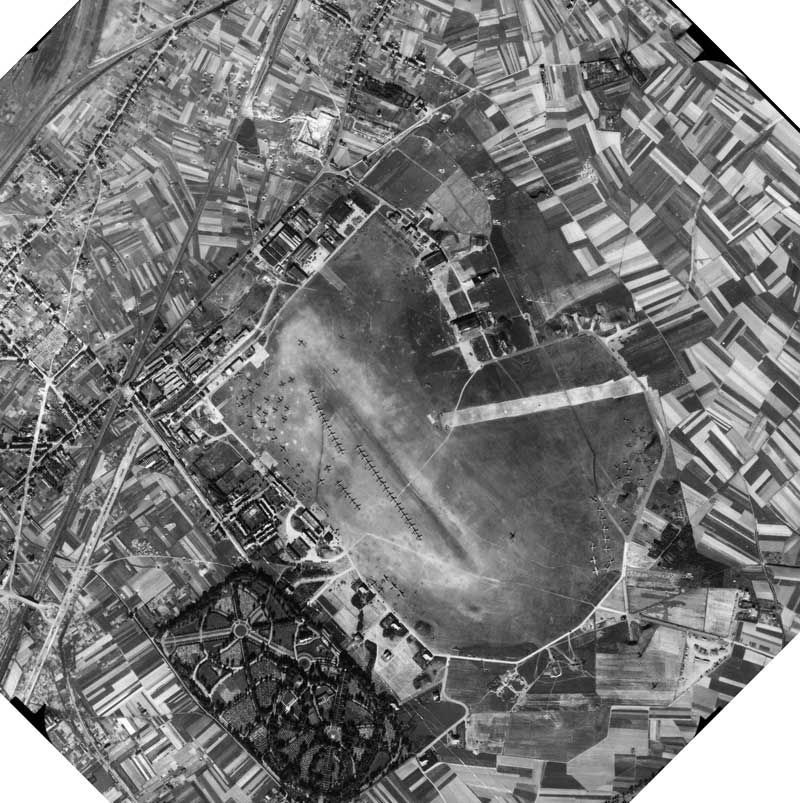
November started on a similar note to October with mail and newspapers joining shipments as diverse as mattresses, clothing and wireless equipment routed to the front largely via the Brussels airfields and B70/ Antwerp. The port facilities at Antwerp were crucial to the allies and the city had been officially liberated on September 6th by the British Second Army assisted by local resistance fighters. However, access to Antwerp is along a 50+ mile stretch of the Scheldt estuary. The Wehrmacht were established along the northern bank of the Scheldt on the peninsula comprising Walcheren Island (with the port of Vlissingen), North Beveland and South Beveland and could prevent shipping entering Antwerp. With the allies advanced to Eindhoven and Nijmegen after Market Garden, a seaborne attack on Walcheren accompanied by land forces from the east seemed necessary. Canadian and British forces commenced the seaborne offensive in the early hours of November 1st and, by 4th, the Germans had been overwhelmed. The breaches in the dykes around Flushing, created during the offensive, took almost a year to close with long-lasting problems for the local agricultural economy.
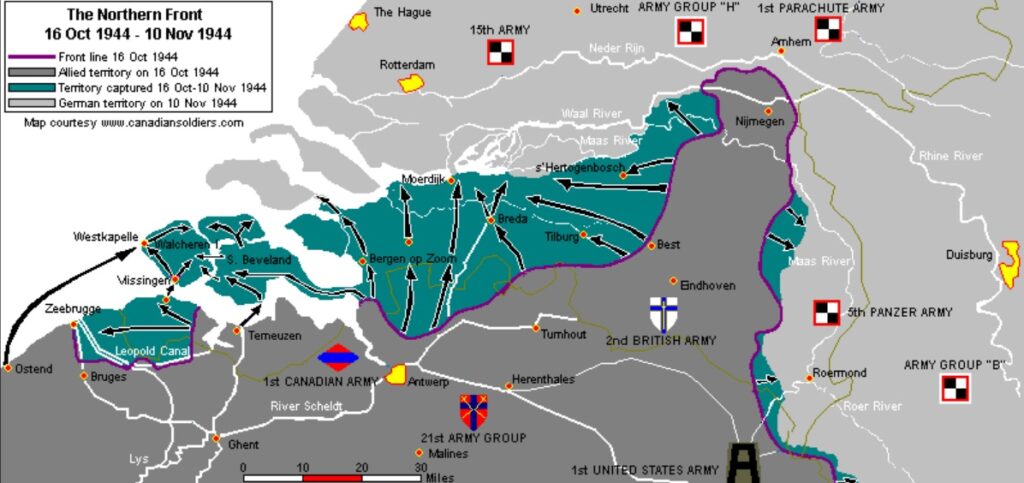
By November 6th, resupply of the allied forces was necessary and six 233 Squadron Dakotas were positioned to B70/ Antwerp on 6th November. Each aircraft was equipped with 16 panniers of supplies. FZ681, flown by F.O Priestley, arrived at B70 at 08:40 and departed for the DZ with the other five aircraft at 10:17. A small amount of enemy flak was encountered but no aircraft were hit and the drop was made successfully to the NW of Vlissingen (Flushing) at 11:03 before returning to Antwerp at 11:20.
On November 9th, nine Dakotas carried Pierced Steel Planking to B51/ Lille to assist with the commissioning of further advanced landing grounds. FZ681 and six other Dakotas repeated the PSP shipment from Lyneham to B51/ Lille the following day and FZ681, alone, carried 4510 lbs of PSP to B51 on 11th November. poor weather in the Cotswolds around the middle of the month saw some flights staging through Ford and Colerne to Brussels/ B58 and B17/ Caen. Passenger flights continued, largely via Northolt, and PSP delivery increased to B79/ Woensdrecht as the allies advanced towards the Maas.
Glider exercises were carried-out on November 16th and 17th with aircraft practising quick take-offs and landings and navigation timing around Blakehill Farm. Additionally, two crews were assigned to glider towing practice each day during November with a squadron total of over 65 hours training achieved. Pannier dropping was practised at night and almost 30 hours of training accumulated. Towards the end of the month, poor weather curtailed some missions and also led to some aircraft being held-over at bases like B58/ Melsbroek for a couple of days while awaiting improved weather. This was unlikely to upset crews as Brussels was considered to be a good city to visit.

233 continued to transfer SAS personnel and stores between the Continent and Wethersfield in Essex, home to both SAS and SOE operations at the end of 1944. Special Operations were, however, the preserve of 38 Group which mounted its clandestine flights from Wethersfield and nearby Earls Colne.
46 Group retained its airborne focus with the Rhine Crossing foreseen as a future mission. Daily glider tow training was continued in parallel with transport operations and, once again, the last day of the month saw a major glider towing exercise.
Early December saw little change in pattern with freight and passengers, newspapers, mail and army shipments at the forefront of operations. Brussels remained the main destination although B77/ Gilze-Rijen in southern Holland was added to the list. Today, in 2021, Gilze Rijen has recently been hearing the sound of P&W Twin Wasps once again. It is a Dutch Air Force base and has recently been the temporary home of the Dutch Dakota Association’s PH-PBA, Princess Amelia.
Bicester was a frequent source of army equipment destined for Brussels and both Down Ampney and Broadwell received casualties evacuated on return flights. Perranporth in Cornwall stretched the Squadron’s zone of operations within England early in december while, between 2nd and 4th, four Dakotas were dispatched to Bordeaux Merignac loaded with petrol. Flights to Toulouse and Bordeaux were made via Merville on the way out and Le Bourget (Paris) on the return.
On 5th December FZ688 and KG420 carried a load of SHEAF equipment to Toussus-le-Noble. Unable to find anyone to sign for the load, they stayed the night then flew back to Blakehill Farm, still with their consignments! Subsequent flights to A77/ Toussus-le-Noble were received more eagerly. B77/ Gilze, B70/ Antwerp and A47/ Orly became frequent destinations during December and Toulouse remained popular. Outbound army freight was frequently from Bicester and the return medical flights generally routed via Down Ampney. Bad weather sometimes led to diversions and KG430‘s mission to B77/ Gilze on December 12th had to land at Earls Colne owing to poor weather conditions further west. Similarly, some flights returning from Brussels on December 22nd and 23rd stopped, rather strangely, at Exeter.
After being flown by a variety of crews (P.O Saunders, P.O Green, F.O Diamond) earlier in the month, FZ681 was back with Flt. Lt Priestley for a Christmas Eve flight from B58/ Melsbroek to Down Ampney with 18 stretcher cases and 6 walking wounded. The weather conditions on December 25th were considered too poor for flying – convenient for those in Britain but less so for the American forces facing the SS advance through the Ardennes towards Bastogne. Hitler had launched the ‘Battle of the Bulge’ through the Belgian mountains on December 16th but 233 Squadron saw little affect until after Christmas when ten aircraft, including FZ681, were despatched to Beaulieu to collect American troops. Lifting from Blakehill Farm just after 11:00 on Boxing Day, the troops were embarked at Beaulieu and the fleet of ten back in the air between 14:00 and 14:30 en route to A83/ Valenciennes in Northern France. Upon return, the Dakotas touched down at Holmesly South, then a USAAF 9th Air Force B-26 base, just North-East of Christchurch, and stayed there for 2 days. A later 6-aircraft mission was returned to Blakehill via Holmesly but with no troops. Poor weather continued until the end of the year with sporadic missions to B70/ Antwerp, B77/ Gilze, B75/ Nivelles, B79/ Woensdrecht and B65/ Maldegen. Flt. Lt. Priestley took FZ681 to Odiham and then on to B51/ Lille as part of a 5-aircraft mission transferring 604 Squadron personnel on the last day of 1944. He returned to Blakehill Farm at 13:50 with 1 passenger on board, while the other four Dakotas flew empty.
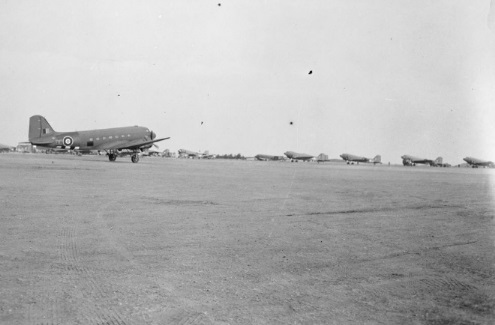
1945
The last year of the war started slowly with a good deal of poor weather curtailing flights on January 2nd, 10th to 12th, 17th to 18th, 23rd to 26th and 30th to 31st and disrupting operations on several other days. KG440, which had departed for Toulouse with a field telephone system on December 26th, had been diverted around France via Le Bourget owing to fog and eventually reached its destination on January 1st. The return journey was equally fraught with a diversion via Ford in Hampshire on January 3rd before arriving home at Blakehill Farm on 4th. The demand for freight, passenger and medical flights to and from Brussels led to a detachment of eight aircraft and twelve crews to B75/ Nivelles, a Belgian Air Force base prior to WW2 (4). They departed for Belgium on January 3rd and operated from there over the winter. Life was far from dull on detachment and the Squadron diaries for January 1945 record that two aircraft collided mid-air en route to B75/ Nivelles on January 9th. Surely an event which could ruin your start to the New Year? Fortunately, both aircraft, KG420 and KG445, landed safely although they remained unserviceable until 17th January. Drop tanks were, again, popular items on the outbound manifests, this time for Mustangs. On the clandestine side, a shipment of captured enemy hardware was flown to Farnborough on January 22nd and SAS personnel and equipment were transferred in and out of Wethersfield. Several visits were also made to the top-secret site at Fersfield where remote-control bomber operations were being developed using PB4Y and B-24 aircraft. Joseph Kennedy Jr flew operations from Fersfield and, tragically, lost his life on 12th August 1944 when his explosive-packed aircraft exploded, probably due to radio/electrical irregularities. On January 28th 1945 KG351, piloted by F.O.Merricks flew 22 US aircrew from B58/ Brussels Melsbroek to the air bases at Debach and Honington. Glider and pannier-dropping training carried on for two crews each day whenever the weather permitted and a single mass glider tow exercise was completed by ten aircraft on January 15th.
(4) Dakotas seconded to B75/ Nivelles in January/ February 1945 were FZ635, FZ685, KG403, KG341, KG455, KG561, KG559 and KG635. KG441 also joined for a time as from February 2nd, perhaps while KG341 was u/s at Lyon.
The main contingent at Blakehill Farm in January comprised: FZ665, FZ678. FZ680, FZ681, FZ686, KG313, KG351, KG400, KG410, KG415, KG420, KG433, KG437, KG440, KG441, KG447, KG448, KG455 and KG585.
February 1945 continued to give some weather problems; one of the aircraft seconded to Nivelles, KG435, had departed via B86/ Helmond in the Netherlands to Millfield in Northumberland on 22nd January and remained snowbound in icy Northumberland for a week before returning to Belgium via Blakehill Farm on February 1st. The detachment to Nivelles continued during February with aircraft rotating back to Blakehill Farm for inspection and repair.Understandably, the Nivelles group flew many flights between the Brussels airfields of B56/ Evere, B75/ Nivelles and B58/ Melsbroek and operated regularly to Low Country destinations such as B70/ Antwerp, B67/ Ursel, B78/ Eindhoven, B76/ Peer, B50/ Vitry-en-Artois and B54/ Achiet. A regular diet of freight, passenger and casualty evacuation flights were operated with local night flying exercises carried-out on February 21st, 22nd, 24th and 27th. Further afield, a number of passenger flights were also operated to and from Lyon during February. One aircraft, KG341, was stranded at Lyon due to technical issues during early February but was eventually repaired and returned to B56/ Brussels where further serviceability issues were diagnosed. KG455 returned to Blakehill for inspection and KG403 was also recalled after it ‘hit a tree’ near Nivelles during poor weather when on a run from B17/ Caen with medical supplies. The RAF maintained a General Hospital at Brussels-Evere and B56 became 233 Squadron’s continental destination for casualty flights. From here, the Blakehill Farm contingent of the Squadron repatriated wounded to Down Ampney.

Much of the work of the Blakehill Farm chapter of the Squadron consisted of delivering freight and passengers to B75/ Nivelles but there were other projects as well. On February 5th, eight aircraft reported to Thorney Island to pick-up 152 personnel of 140 Wing for transfer to B87/ Rosieres-en-Santerre. The squadrons on the move to B87 were 21 Squadron RAF, 467 Squadron RAAF and 487 Squadron RNZAF with their Mosquito fighter/ bombers which made a speciality of attacking Gestapo HQ buildings (5).
Glider towing practice continued with a mass exercise from Blakehill on February 8th as training for the future Rhine Crossing.
Many of the flights from Blakehill Farm to Nivelles during the second week of February 1945 carried troops on the outward leg, casualties and passengers on the return- usually to Down Ampney and Northolt respectively. By the end of the month, quite large numbers of 6th Airborne personnel were being flown from B75 back to England. Some enemy POWs were also flown back to Northolt, a consignment of Dutch currency shipped from Bovingdon to Brussels and USAAF aircrew flown home to their bases at Honington, Ridgewell, Bassingborne, Snetterton Heath and North Pickenham. Sixteen ENSA entertainers and their theatrical props were also conveyed from B75/ Nivelles to Northolt on February 21st. Poor weather curtailed operations on February 12th, 15th, 16th, 18th and 19th, but Spring was on the way and, before long, the end of the war in Europe.
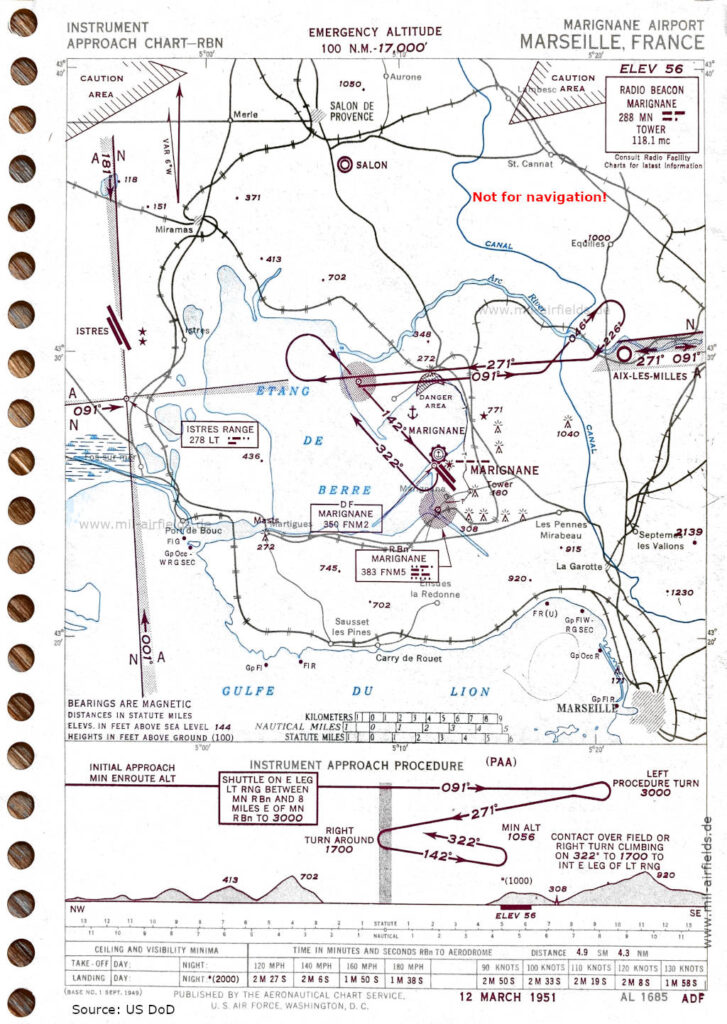
The Nivelles ‘B’ detachment continued for the first half of March 1945 with frequent operations between B77/ Gilze-Reijen in Holland and B65/ Maldegem in Belgium, often moving casualties. Several flights were also made to the south of France with services to Lyon on 3rd March and 7th March (KG441). FZ685 headed to Marseilles-Istres from B75/ Nivelles on 6th March, returning to Brussels Evere from Marseille-Marignane. Three days later KG561 flew from B61/ St.Denis to Marseille before returning to Evere. KG341 repeated the trip on March 10th and , returning to B56/ Evere on March 13th, was the last of the detachment aircraft to return to Blakehill Farm. The other seven Dakotas, FZ685, KG561, KG410, KG559, KG441, FZ635 and KG403, had been packed with 20,000lbs of the units freight and 45 personnel split between them for the flight home to Blakehill Farm on 12th March.
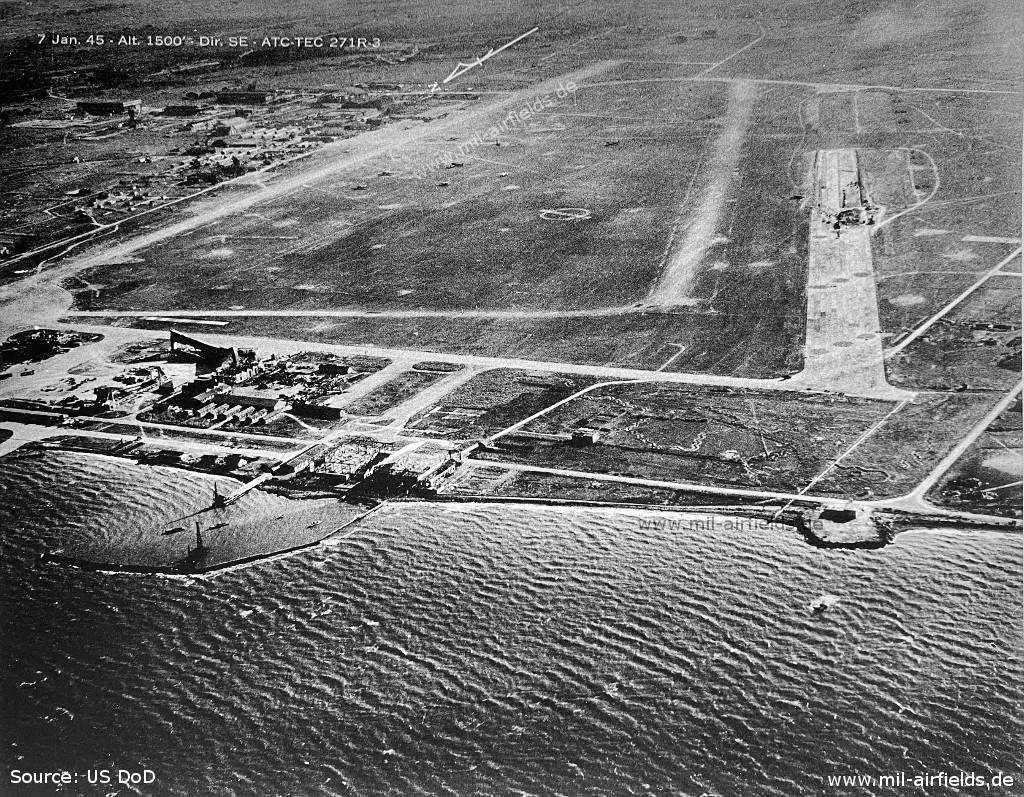
The main unit had also spent much of the early part of March flying to Nivelles from Blakehill Farm. Three aircraft carried Polish Red Cross stores to A82/ Verdun on March 1st and FZ681, flown by Flt. Lt.Cody, transported 20 passengers from Northolt to B78/ Eindhoven, returning via Nivelles. The following morning, Flt. Lt. Priestley’s crew flew FZ681 from Northolt to Le Bourget with the New Zealand Rugby team on board. Much of the freight carried during the month followed the previous pattern: general stores, pierced steel planking for airfield runways, drop tanks for Fighter Command. The 85 Group personnel necessary for building the airstrips were also transferred from Northolt to B51/ Lille and B48/ Amiens by KG313 and KG400 on March 4th. The following day, March 5th, was dedicated to glider towing exercises before the Squadron was back to troop-transfer duties with a 10-aircraft mission carrying Canadian troops to B56/ Evere and B75/ Nivelles on March 6th. The 7th was another routine day with operations which included three Dakotas taking 121 Wing personnel to the Typhoon and Tempest squadrons based at B80/ Vokel in eastern Holland. FZ681, flown by Flt.Lt. Priestley, carried Spitfire drop tanks to B56/ Evere. On March 8th, ten aircraft collected medical supplies and blankets from Greenham Common. The following day, eight aircraft, including FZ681, started distributing the medical supplies with a flight to A93/ Liege. While some of the return flights continued to carry casualties and empty blood boxes, there were more empty stages operated as the Allies successfully pushed eastwards to the Rhine.
Another large shipment of stores was transferred to Nivelles by 12 aircraft on 12th March and, the following day, another ten aircraft repeated the operation. As ‘B’ flight was returning to Blakehill Farm, eight of these Dakotas returned empty while FZ681 and KG585 helped-out transferring ‘B’ flight personnel. Also on March 13th, three Dakotas KG400, KG420 and KG455, transferred 53 SAS troops from the SOE airfield at Earls Colne in Essex to B75/ Nivelles. A day of glider towing exercises on March 14th was followed by a 10-aircraft operation taking equipment from Perranporth in Cornwall to B56/ Brussels Evere on March 15th. On the same day, FZ680, flown by Sgt Neil, transported Prince Bernhardt from Brussels to White Waltham. Another nine aircraft were assigned to the Perranporth to B56 operation on March 17th and, on the 18th, ten Dakotas transferred RAF personnel between Warmwell and B86/ Helmond with 151 outbound and 166 inbound. Another new destination in Belgium was B71/ Coxyde which was visited by FZ681 on March 18th. Bad weather intervened on March 19th and another 14-aircraft mission was flown between Perranporth and B56 on 20th. On March 21st, twenty-six 233 Squadron Dakotas flew from Blakehill Farm to Birch airfield in Essex with accompanying Horsa gliders ready for Operation Varsity, the Rhine Crossing.
Hits: 421
